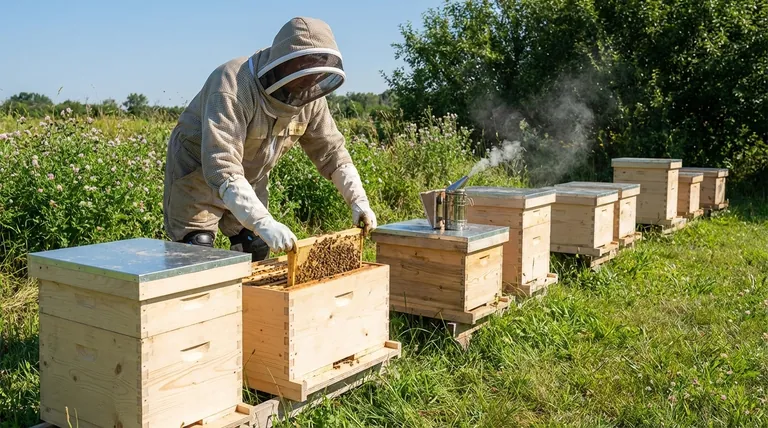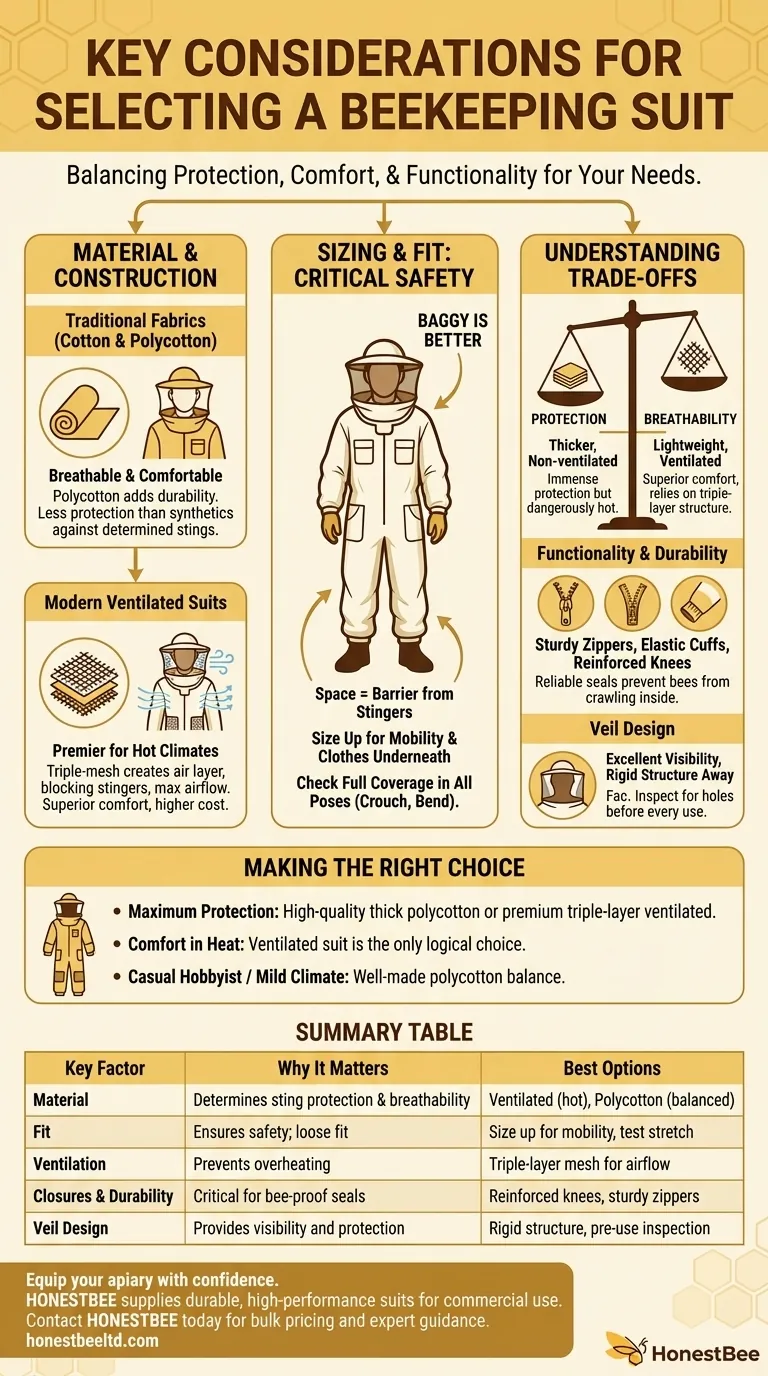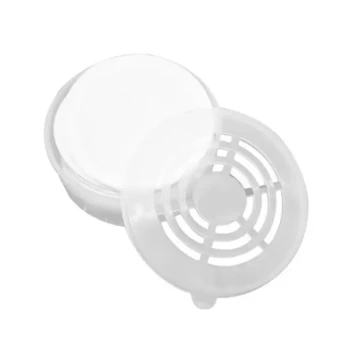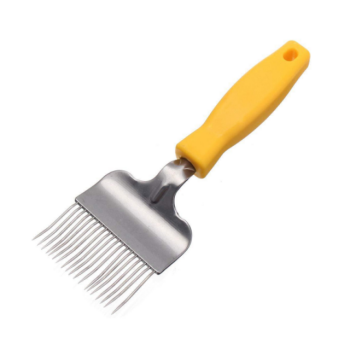When selecting a beekeeping suit, your decision must balance protection, comfort, and functionality. The best choice depends on your climate, the temperament of your bees, and how often you'll be in the apiary. Key factors include the suit's material, ventilation, fit, and the quality of its closures like zippers and cuffs.
Your goal is not to find an impenetrable suit of armor, but to find the right tool for the job. The ideal suit provides enough protection to give you confidence while offering enough comfort to keep you calm and focused, which is your ultimate safety tool.

The Foundation: Material and Construction
The material of your suit is the primary determinant of both its protective capability and its comfort level, especially concerning heat.
Traditional Fabrics: Cotton and Polycotton
Cotton is a popular, traditional choice valued for its breathability and comfort against the skin.
While comfortable, standard-weight cotton may offer less protection against determined stings compared to thicker, synthetic options.
Polycotton blends (polyester and cotton) offer a good compromise. They increase durability and sting resistance while retaining a good degree of comfort.
Modern Ventilated Suits
Ventilated suits, often made of a triple-mesh construction, are the premier choice for beekeeping in hot climates.
These suits work by creating a thick layer of air between two mesh fabrics that a bee's stinger cannot bridge, all while allowing maximum airflow to keep you cool.
Though often more expensive, their superior comfort in the heat allows for longer, less stressful hive inspections.
Sizing and Fit: A Critical Safety Layer
An improper fit is a common failure point that can compromise an otherwise excellent suit. The goal is a loose, baggy fit.
Why "Baggy" Is Better
A baggy suit ensures the fabric stays away from your skin. This space is a crucial barrier; if a bee stinger penetrates the material, it is less likely to reach you.
Sizing Over Your Clothes
Always select a suit that is one size larger than your typical clothing. You will be wearing it over your clothes, and you need room for unrestricted movement.
The Stretch Test
Ensure the suit provides full coverage even when you are crouching, bending, or stretching. The cuffs should not ride up your wrists or ankles, exposing skin.
Understanding the Trade-offs
Every bee suit design involves compromises. Understanding them allows you to choose the right balance for your needs.
Protection vs. Breathability
This is the central trade-off. A thicker, non-ventilated suit offers immense protection but can be dangerously hot and cumbersome in warm weather.
A lightweight, ventilated suit offers superior comfort but relies on its triple-layer structure, not sheer thickness, for protection. Always inspect these for quality construction.
Functionality and Durability
High-quality, sturdy zippers are non-negotiable. A failed zipper mid-inspection is a critical safety hazard.
Elastic cuffs and ankle closures must be robust enough to create a reliable seal that prevents bees from crawling inside the suit.
Reinforced knees and well-placed tool pockets are features of a quality suit designed for frequent, practical use.
The Importance of the Veil
Your veil is your window into the hive. Prioritize a design that offers excellent visibility and is held rigidly away from your face.
Before every use, inspect your entire suit—especially the veil and seams—for any holes or tears. A small opening is an open invitation.
Making the Right Choice for Your Goal
Select your suit based on a clear-eyed assessment of your primary need.
- If your primary focus is maximum protection: Choose a high-quality, thick polycotton suit or a premium triple-layer ventilated suit from a reputable brand.
- If your primary focus is comfort in a hot climate: A ventilated suit is the only logical choice and is worth the investment.
- If you are a casual hobbyist in a mild climate: A well-made polycotton suit offers an excellent balance of protection, durability, and cost.
Ultimately, your suit is a tool that enables you to work with your bees confidently and safely.
Summary Table:
| Key Factor | Why It Matters | Best Options |
|---|---|---|
| Material | Determines sting protection & breathability | Ventilated triple-mesh (hot climates), Polycotton (balanced protection) |
| Fit | Ensures safety; loose fit keeps fabric away from skin | Size up for mobility, test stretch & coverage |
| Ventilation | Prevents overheating during long hive inspections | Triple-layer mesh for maximum airflow |
| Closures & Durability | Critical for bee-proof seals; zippers/cuffs must be reliable | Reinforced knees, sturdy zippers, elastic cuffs |
| Veil Design | Provides visibility and face protection | Rigid structure away from face, pre-use inspection for holes |
Equip your apiary with confidence. HONESTBEE supplies durable, high-performance beekeeping suits and equipment designed for the demands of commercial beekeepers and distributors. Our wholesale-focused operations ensure you get the right gear for your climate and bee temperament, balancing superior protection with essential comfort.
Contact HONESTBEE today for bulk pricing and expert guidance on selecting the ideal suits for your operation.
Visual Guide

Related Products
- Wholesales Dadant Size Wooden Bee Hives for Beekeeping
- Yellow Plastic Bucket Pail Perch for Beekeeping
- Long Langstroth Style Horizontal Top Bar Hive for Wholesale
- Professional Insulated Plastic Bee Hives
- Professional Insulated Winter Hive Wrap for Beekeeping
People Also Ask
- How often should the area under beehives be inspected and cleaned during the warm season? A Proactive Maintenance Guide
- Why were wooden hives traditionally preferred? For Natural Beekeeping Aligned with Bee Biology
- What are the essential pieces of equipment for most beekeepers? Get Started with the Right Gear
- What types of products are available for beekeeping needs? Essential Equipment for Apiaries & Distributors
- What is beekeeping equipment? Essential Tools for Commercial Apiaries & Distributors



















